What is a Warehouse Management System (WMS)?
Date
Oct 27, 25
Reading Time
11 Minutes
Category
Custom development
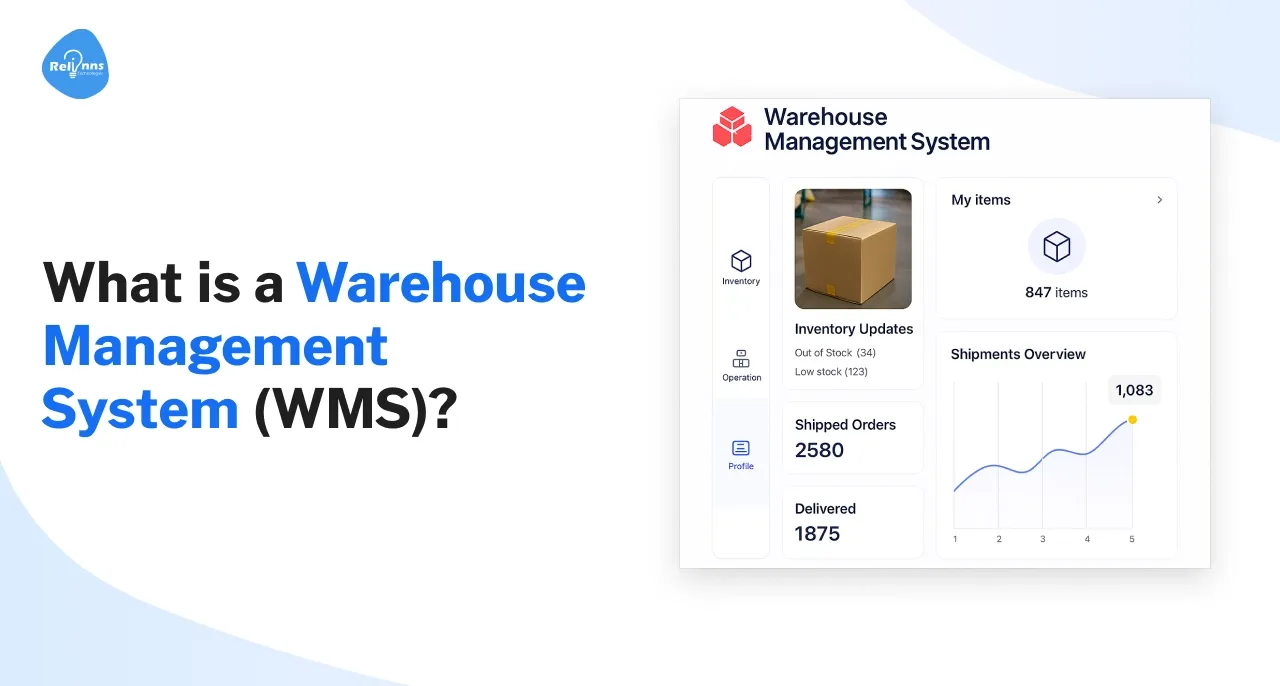
Every misplaced box costs more than you think: time, labour, and unhappy customers. Studies show that 1–3% of all orders in many warehouses are picked incorrectly, and a single picking error can reduce an order's profitability by up to 13%.
A Warehouse Management System (WMS) doesn’t just organize shelves; it organizes your entire operation. From inventory tracking to order fulfillment, it keeps everything running on time and error-free.
With a WMS, managers know exactly what’s in stock, where it’s stored, and when it’s moving without endless spreadsheets or manual checks. It’s the difference between reacting to problems and preventing them.
In this blog, we’ll understand what a Warehouse Management System is, how it works, its benefits, and how it’s reshaping logistics management for businesses everywhere.
Let’s begin.
What Is a Warehouse Management System (WMS)?
A Warehouse Management System (WMS) is a digital tool that manages every warehouse operation, from inventory control and order tracking to warehouse optimization and shipping.
Instead of juggling spreadsheets or manual checklists, a WMS gives real-time visibility into what’s happening across the floor. It tracks inventory movement, automatically updates stock, and helps teams make quicker, more accurate decisions.
The system also connects with supply chain and shipping software, as well as SAP integration tools, to keep operations aligned. That means smoother logistics management, fewer delays, and better order tracking, all from one platform.
Core Purpose of WMS
- Streamlines warehouse operations for faster, more accurate order handling.
- Reduces manual work by automating processes to improve efficiency.
- Provides real-time inventory tracking and visibility across locations.
- Delivers actionable insights through analytics for better decision-making.
- Connects with supply chain software and SAP integration for seamless coordination.
Now that we have understood what exactly WMS is. Now, let’s take a quick look at the comparison of how WMS differs from ERP, IMS, and TMS systems.
WMS vs ERP vs IMS vs TMS
WMS, ERP, IMS, and TMS often sound similar, but each serves a different role in how businesses manage operations.
Here’s a quick comparison to help you understand how these systems work together within modern supply chain software.
System | Focus | Key Features | Ideal For | Integration |
WMS | Warehouse operations | Inventory tracking, warehouse automation, order tracking, and real-time analytics | Businesses optimizing warehouse management in logistics | Works with supply chain software, shipping software, and SAP integration |
ERP | Business-wide processes | Finance, HR, procurement, and production management | Enterprises managing multiple departments | Integrates with WMS for warehouse data |
IMS | Stock control | Stock levels, reorder alerts, and inventory control | Retailers, eCommerce, and wholesalers | Syncs with WMS and POS systems |
TMS (Transportation Management System) | Transportation & delivery | Route planning, delivery tracking, and carrier performance | Logistics and distribution companies | Connects with ERP, WMS, and shipping software |
All four systems work together to keep operations seamless. Still, the Warehouse Management System ties it all together: driving efficiency, speed, and precision across every process, which brings us to how it truly benefits warehouse performance.
So let’s go through it.
What Are the Benefits of a Warehouse Management System?
A Warehouse Management System (WMS) helps warehouses run more innovatively and more efficiently.
Let’s learn how a WMS creates a measurable impact in real operations.
Improved Inventory Accuracy
In a case study conducted by an Anotregional distribution centre, Academia found that outbound lead time dropped from 9.94 days to 4.29 days, a 57% reduction. Thanks to better stock management.
Better Decision-Making
WMS provides dashboards and logistics management tools that make demand forecasting and resource planning more effective. The regional case study showed that WMS adoption had a “positive impact” on operational control and strategy.
Reduced Lead Time & Process Efficiency
A comparative case study published in ScienceDirect across multiple warehouses found that WMS implementation significantly reduced process times by streamlining receiving, picking, and dispatch operations.
Continuous Optimization of Warehouse Resources
One academic paper by irjet.net states that WMS “enables us to analyze these components continually, so we can conserve effort, fill orders faster and more accurately, save space, and reduce inventory.
Operational Efficiency and Integration Gains
A systematic literature review by odr.chalmers.se found that WMSs help simplify operational processes, optimize strategies, and integrate with emerging technologies through real-time information flows.
Sustainability & Lower Environmental Footprint
Research conducted by mdpi.com suggests that WMS contributes to sustainable logistics (less waste, more efficient resource use) by coordinating systems more tightly.
A Warehouse Management System builds the foundation for accurate, scalable, and future-ready logistics, keeping every part of the warehouse in perfect sync.
How Does a Warehouse Management System Work?
A Warehouse Management System (WMS) serves as the command center for all warehouse operations. It tracks goods from the moment they arrive to they leave the facility.
Let’s break down how this all works step-by-step.
1. Receiving Goods and Verifying Stock
When new goods arrive, the WMS scans barcodes or RFID tags to record them instantly. It checks quantities, verifies against purchase orders, and updates inventory control systems in real time.
2. Placing Items in the Correct Storage Zones
Once verified, the WMS guides staff to place items in optimal storage locations based on demand, size, and picking frequency, supporting efficient warehouse optimization.
3. Picking and Packing Orders
When an order comes in, the WMS automatically generates a picking list. It directs workers to the correct shelves, reducing search time and improving order-tracking accuracy.
4. Labeling and Integration with Shipping Software
Before shipment, the WMS prints the shipping labels and barcodes. It syncs with shipping software like FedEx, UPS, or DHL for seamless dispatch and tracking updates.
5. Tracking Shipments and Returns
Once shipped, every parcel is tracked through integrated logistics management systems. If a return occurs, the WMS manages restocking while maintaining updated inventory data.
Role of Automation Systems
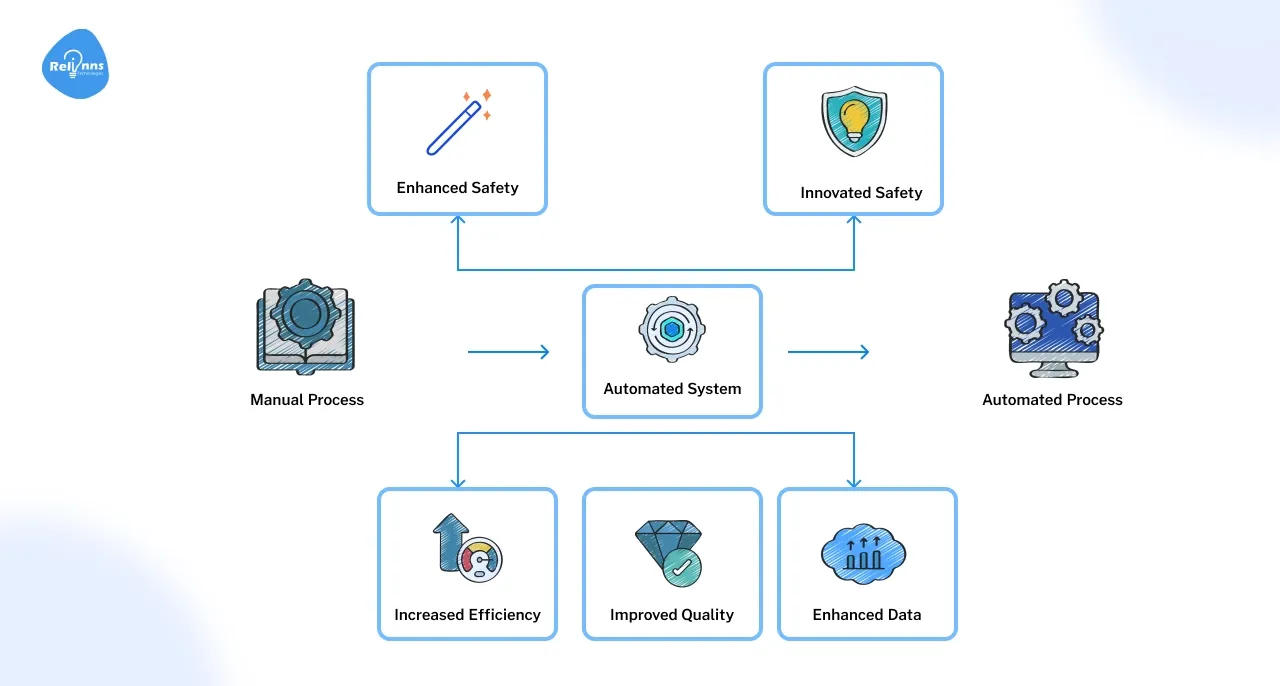
Business process Automation is what makes a modern Warehouse Management System Software truly powerful.
- Barcoding & RFID: Replace manual entries, ensuring fast, error-free scanning and stock verification.
- IoT Devices: Monitor temperature, humidity, and movement for sensitive goods.
- Robotics & Conveyor Systems: Handle repetitive tasks like sorting, stacking, and moving goods to improve throughput.
- SAP Integration & Analytics: Syncs data across departments for real-time visibility and more thoughtful decision-making.
- Automated Guided Vehicles (AGVs) & AMRs: Transport goods autonomously across the warehouse, reducing transit time and manual handling.
- AI-Powered Predictive Maintenance: Detect equipment issues early to prevent downtime and keep operations running smoothly.
- Digital Twin Simulation: Test layouts and automation flows virtually to optimize performance without disruptions.
- Automated Quality Control: Use AI and sensors to inspect goods in real time, ensuring accuracy and consistency.
- Voice & Wearable Tech: Enable hands-free picking and navigation to accelerate and improve safety in warehouse operations.
These automation systems turn routine warehouse tasks into efficient, data-driven operations that save time and reduce costly errors.
What Are the Key Features of a Warehouse Management System?
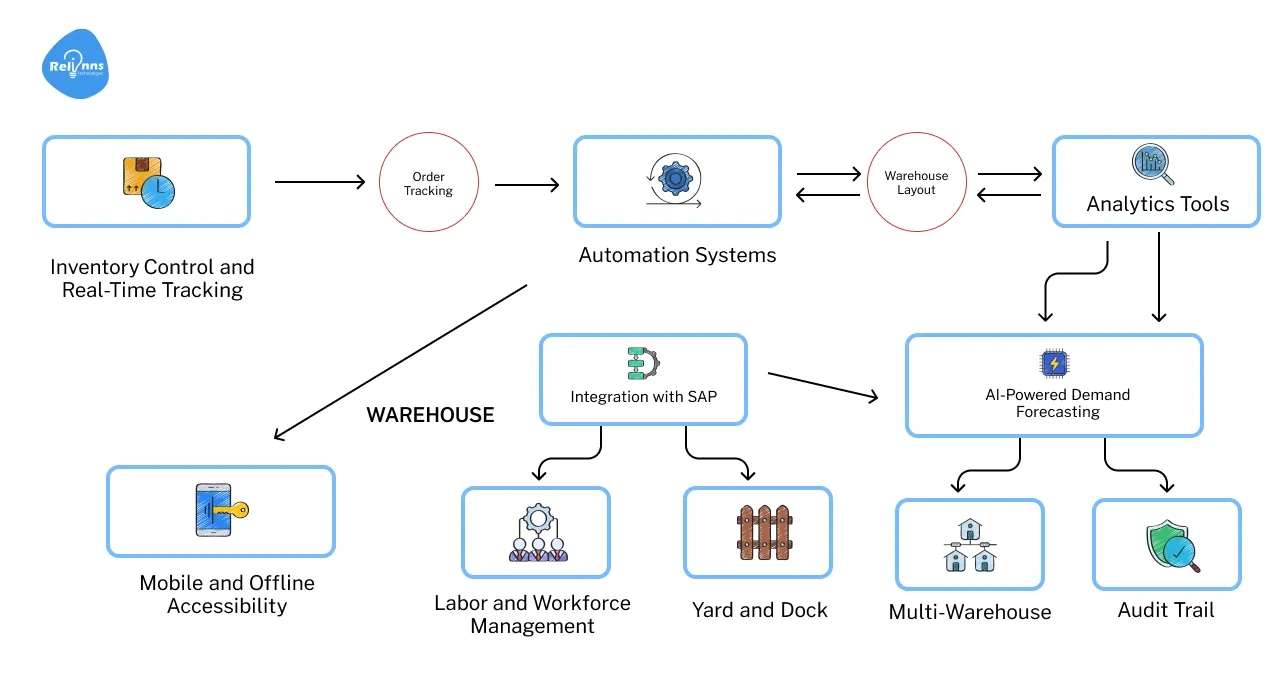
Today, Warehouse Management System Software offers deep integration, predictive insights, real-time visibility, and much more.
So let’s take a look at what more features a Warehouse Management System provides. These features are key whether you use a custom low-code solution like Joget, Mendix, or a system like Oracle WMS Cloud.
1. Inventory Control and Real-Time Tracking
Stay on top of every item with barcode scanning and IoT sensors. Real-time inventory tracking helps prevent stockouts, overstocking, and misplaced goods.
2. Order Tracking and Management
A WMS automates picking, packing, and order tracking using Joget, ensuring every shipment is accurate and on time. Customers and staff always know where each order stands.
3. Automation Systems (Barcode, IoT, Robotics)
From barcode scanners to robots, automation systems handle repetitive work efficiently, improving speed, accuracy, and worker safety.
4. Warehouse Layout and Space Optimization
Using data insights, WMS designs layouts that reduce travel time, improve storage, and boost warehouse optimization for higher productivity.
5. Reporting and Analytics Tools
Dashboards track key metrics such as accuracy, speed, and labor utilization. Real-time data powers smarter, faster decisions.
6. Integration with SAP and Enterprise Systems
With SAP integration and connections to supply chain software and shipping software, WMS unifies your entire logistics management process under one system.
7. AI-Powered Demand Forecasting
AI-based forecasting helps predict stock levels, seasonal trends, and reorder points. It reduces waste, improves inventory control, and keeps operations proactive rather than reactive.
8. Labor and Workforce Management
Monitor employee performance, assign tasks, and optimize shift scheduling. Built-in analytics track productivity, helping reduce labor costs and balance workloads across the warehouse.
9. Yard and Dock Management
Simplify inbound and outbound logistics with dock scheduling and yard tracking. A smart WMS coordinates trailer movements, reduces congestion, and ensures faster loading and unloading times.
10. Multi-Warehouse and Distributed Fulfillment
Manage multiple warehouse locations from one platform. Transfer stock, balance inventory levels, and fulfill orders seamlessly across regions for consistent service and visibility.
11. Audit Trail and Compliance Controls
Keep every operation traceable with automatic audit logs and activity records. This feature supports compliance with industry regulations and ensures data integrity during inspections.
12. Mobile and Offline Accessibility
Empower your warehouse teams with mobile WMS access. Workers can scan, update, and manage stock in real time, even in low-connectivity zones, improving flexibility and speed.
What Are the Cost Factors Associated with a Warehouse Management System?
Understanding what drives the total cost is essential before implementation. From software setup to SAP integration and training, several factors influence the final price.
Software Licensing or Subscription
Cloud-based Warehouse Management System Software typically charges monthly or annually, while on-premise solutions require a one-time license plus maintenance fees.
Setup and Customization
Custom workflows, inventory tracking, and integration with existing supply chain software can raise setup costs, especially for complex warehouses.
Using Joget’s DX low-code platform, organisations have achieved reductions of up to 50%- 90% in development costs compared with traditional software development.
Staff Training and Technical Support
Training teams on new systems ensures smooth adoption. Ongoing technical support helps avoid disruptions and maintain system performance.
Integration with SAP and External Systems
Connecting a WMS to SAP, ERPs, or shipping software may involve additional development or consulting fees.
Hardware Costs for Scanners or Automation
Barcode scanners, RFID readers, and other automation systems often incur separate costs, which depend on warehouse size and technology level.
Typical Pricing Range
- Small / Mid Operations: Cloud subscriptions at $100–$500 per user/month, with base fees starting near $2,000/month.
- Mid-Enterprise / Custom Deployments: Implementation plus licensing may cost $10,000 to $50,000+, depending on complexity.
- Large / Enterprise Scale: On-premises or highly integrated systems often exceed $100,000, especially when factoring in full SAP integration for Warehouse Management and high automation.
What Are the Challenges of Implementing a Warehouse Management System?
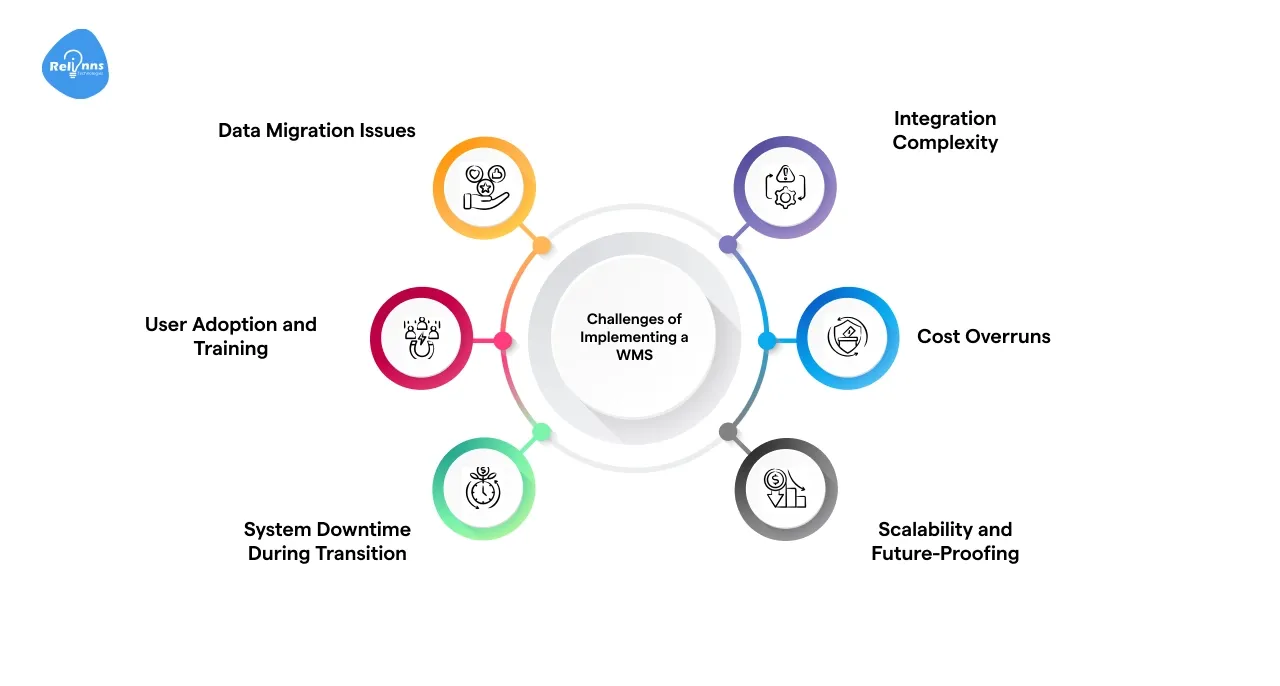
From data migration errors to integration roadblocks, even the smallest misstep can slow operations and inflate costs.
Here’s what often goes wrong and how to stay ahead.
1. Data Migration Issues
Moving old records into a new system often exposes errors and inconsistencies. Poor data cleanup can disrupt inventory control and reporting accuracy.
Audit, cleanse, and validate your data before migration to ensure a seamless transition.
2. Integration Complexity
Connecting WMS with ERP systems, SAP integration, or supply chain software can be tricky. Misaligned data formats and workflows often cause system slowdowns.
Using open APIs or middleware solutions simplifies this process and ensures real-time visibility.
3. User Adoption and Training
Employees may hesitate to trust new automation systems or digital dashboards. Without proper onboarding, adoption rates drop.
Early involvement, role-based training, and easy-to-use interfaces help users embrace the change.
4. Cost Overruns
Without a clear scope or milestones, implementation costs can spiral. Custom Warehouse Management System Software projects, especially those involving warehouse automation, can quickly exceed budgets.
Careful planning and continuous cost development tracking by using tools like Joget prevent overruns.
5. System Downtime During Transition
Switching to a new WMS can temporarily slow operations, especially if legacy and new systems overlap.
A phased rollout minimizes disruptions and maintains consistent order fulfillment.
6. Scalability and Future-Proofing
Some systems struggle to scale as warehouses expand or adopt new technologies.
Choosing a flexible, cloud-based Warehouse Management System in logistics ensures long-term adaptability.
While challenges are inevitable, a proactive strategy, a well-organized team, and the right partner make implementation smoother and more rewarding.
How to Choose a Warehouse Management System (WMS)?
The goal isn’t just picking a tool but finding one that fits your workflows, scales with growth, and integrates seamlessly with your ecosystem.
Therefore, researching various Warehouse Management System Examples, such as SAP EWM or tailored Joget applications, is crucial before investing.
Scalability and Flexibility
Pick a WMS that grows with your business, supports multi-site operations, and adapts to future tech upgrades. Scalability remains a top-3 selection factor for 2025 buyers.
Integration and Compatibility
Ensure it integrates smoothly with ERP, SAP, and supply chain software for error-free data flow, real-time order tracking, and automation across all departments.
Functionality and Feature Fit
Choose software with essential features like inventory control, analytics, and warehouse automation. Data-driven warehouses run 20% faster, according to McKinsey research.
Ease of Use and Training
Even the most advanced software fails if your team can’t use it effectively. Look for user-friendly dashboards, clear workflows, and accessible mobile interfaces.
Data Security and Compliance
As more systems move to the cloud, protecting warehouse data becomes critical. Ensure your WMS provider complies with standards like GDPR, SOC 2, and ISO 27001.
Real-Time Analytics and Reporting
Opt for systems with dashboards that provide live visibility into warehouse KPIs, enabling faster forecasting and smarter decision-making.
Customization and Extensibility
Select a flexible, API-ready WMS that allows custom workflows and automation systems tailored to your warehouse model.
Vendor Support and Total Cost
Evaluate post-deployment support, upgrades, and total ownership cost, not just initial licensing. Reliable vendors simplify scaling.
The right Warehouse Management System in logistics aligns tech with operations and unlocks lasting efficiency gains.
Future of Warehouse Management System
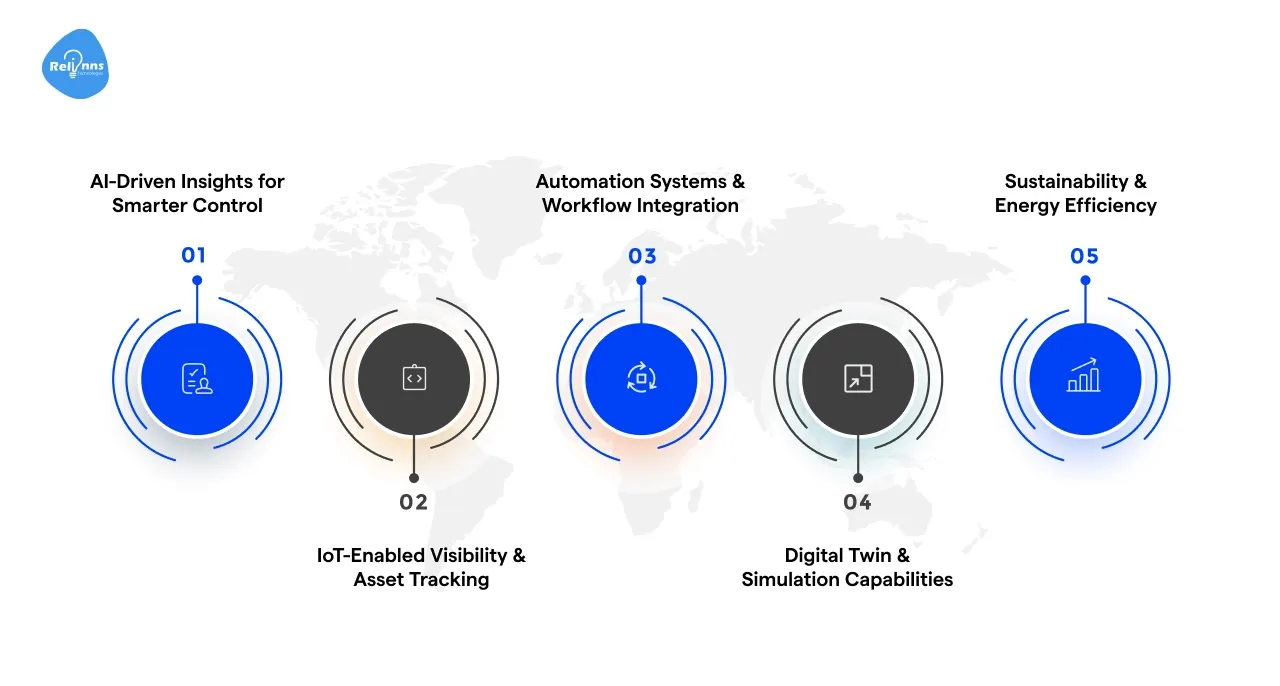
The role of a WMS has shifted. Integrating AI and IoT transforms traditional systems into dynamically responsive engines for inventory control, warehouse automation, and logistics management.
Let’s understand how.
AI-Driven Insights for Smarter Control
AI empowers WMS platforms to analyze massive streams of data from sensor data to order flows, enabling real-time decision-making.
IoT-Enabled Visibility & Asset Tracking
IoT devices such as RFID tags, smart sensors, and connected gateways fuel inventory tracking and operational transparency.
Automation Systems & Workflow Integration
Combined AI + IoT unlock deep warehouse optimization from robotics-aided picking to predictive maintenance. For example, WorldMetrics reports show that warehouses using digital tools saw order accuracy improve by over 80% and inventory errors decrease by 30%.
Digital Twin & Simulation Capabilities
Digital twins enable warehouses to simulate layouts and workflows before implementation, improving optimization and reducing costly trial-and-error. IIoT-World notes that by 2025, warehouses using AI, IoT, and digital twins will cut costs, speed deliveries, and create more resilient supply chains.
Sustainability & Energy Efficiency
AI and IoT make warehouses smarter and greener. Smart sensors optimize lighting, HVAC, and energy use to reduce waste. WorldMetrics reports that AI-driven warehouses lower excess stock by 30% and energy use by 35%, improving efficiency and sustainability.
Conclusion: Choosing the Right Warehouse Management System Partner
Selecting the right Warehouse Management System (WMS) partner can define your warehouse’s efficiency and long-term growth. A strong WMS not only streamlines inventory tracking and order management but also integrates automation systems, SAP, and supply chain software to build truly connected operations.
Among the top WMS providers, Relinns Technologies stands out for delivering custom-built, scalable, and AI-powered warehouse solutions tailored to each business. Relinns combines cutting-edge automation, data-driven logistics management, and cloud-based technology to enhance accuracy, reduce development costs, and boost performance.
Why Choose Relinns?
- Custom-built WMS aligned with your business workflow
- 40% faster deployment to implement your custom solution in weeks or days.
- Seamless integration with SAP and supply chain software
- AI and IoT-powered automation is improving accuracy by up to 45%
- Scalable architecture for multi-warehouse operations
- 24/7 support with rapid response and continuous optimization
Frequently Asked Questions (FAQ's)
How does a Warehouse Management System improve customer satisfaction?
A WMS speeds up order fulfillment, reduces shipping errors, and provides real-time order tracking, helping businesses deliver faster and more accurately, directly improving customer experience and trust.
Can small businesses benefit from a Warehouse Management System?
Yes, modern cloud-based WMS solutions are affordable, easy to scale, and designed for small operations to manage inventory efficiently without needing complex infrastructure.
What technologies power modern Warehouse Management Systems?
Today’s WMS uses AI, IoT sensors, and automation tools to enhance inventory tracking, optimize warehouse space, and provide data-driven insights for better decision-making.
Can WMS be integrated with existing ERP or SAP systems?
Yes, most Warehouse Management Systems integrate seamlessly with ERP and SAP platforms, ensuring smooth data flow across logistics, accounting, and supply chain operations.
How do companies measure the ROI of implementing a WMS?
Businesses typically track metrics like reduced labor costs, faster delivery times, fewer stock discrepancies, and improved order accuracy to calculate the WMS’s return on investment.
What are the best Warehouse Management System Examples available today?
Top Warehouse Management System Examples include enterprise systems, low-code tools like Joget and Mendix for custom solutions, SAP EWM and Oracle WMS Cloud, and specialized platforms like Manhattan Associates.



